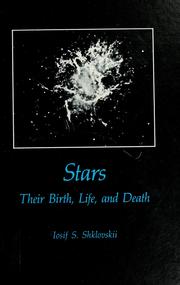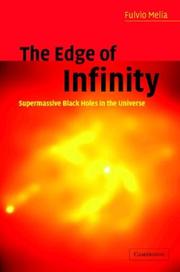| Listing 1 - 10 of 136 | << page >> |
Sort by
|
Book
ISBN: 3031356284 3031356276 Year: 2023 Publisher: Cham, Switzerland : Springer International Publishing AG,
Abstract | Keywords | Export | Availability | Bookmark
 Loading...
Loading...Choose an application
- Reference Manager
- EndNote
- RefWorks (Direct export to RefWorks)
This book aims at providing an accessible, and yet comprehensive and self-contained discussion of compact stars. After a pedagogical introduction to the physics of white dwarfs, the bulk of the book is devoted to the analysis of the structure and dynamics of neutron stars. A great deal of emphasis is placed on the dynamical models underlying the description of neutron star matter at microscopic level. The analysis of these models is inherently cross-disciplinary - from nuclear and particle physics to astrophysics and condensed matter physics and the relevant concepts are introduced following a didactic approach, drawing largely on the historical development of the field. The impact of the latest experimental data, such as gravitational waves emissions, and the potential of future observational developments in the new era of multimessenger astronomy are extensively discussed. This volume is intended to provide PhD students in physics and astrophysics with solid foundations for their future research career. It is also a useful tool for the broader audience of more advanced readers, working in the fields of nuclear and particle physics as well as gravitational physics.
Book
ISBN: 1316853225 1316850773 1316848353 Year: 2020 Publisher: Cambridge : Cambridge University Press,
Abstract | Keywords | Export | Availability | Bookmark
 Loading...
Loading...Choose an application
- Reference Manager
- EndNote
- RefWorks (Direct export to RefWorks)
This self-contained introduction to compact star physics explains important concepts from areas such as general relativity, thermodynamics, statistical mechanics, and nuclear physics. Containing many tested exercises, and written by an international expert in the research field, the book provides important insights on the basic concepts of compact stars, discusses white dwarfs, neutron stars, quark stars and exotic compact stars. Included are sections on astrophysical observations of compact stars, and present and future terrestrial experiments related to compact stars physics, as the study of exotic nuclei and relativistic heavy-ion collisions. Major developments in the field such as the discovery of massive neutron stars, and a discussion of the recent gravitational wave measurement of a neutron star merger are also presented. This book is ideal for graduate students and researchers working on the physics of compact stars, general relativity and nuclear physics.
Book
ISBN: 1536105252 9781536105254 1536105074 9781536105070 Year: 2017 Publisher: New York
Abstract | Keywords | Export | Availability | Bookmark
 Loading...
Loading...Choose an application
- Reference Manager
- EndNote
- RefWorks (Direct export to RefWorks)
Neutron stars. --- Compact objects (Astronomy) --- Stars --- Pulsars
Book
ISBN: 0511564767 Year: 1994 Publisher: Cambridge : Cambridge University Press,
Abstract | Keywords | Export | Availability | Bookmark
 Loading...
Loading...Choose an application
- Reference Manager
- EndNote
- RefWorks (Direct export to RefWorks)
What evidence is there for and against unified schemes for active galactic nuclei (AGN)? How do the AGN populations evolve over cosmological timescales? And what can the variability of their UV and X-ray emission tell us? These are just some of the exciting issues addressed in this volume of papers collected from the 33rd Herstmonceux conference in Cambridge. AGN are among the most spectacular objects known to astronomy. Yet, despite years of intense and wide-ranging research, the debate continues - what is their fundamental source of power? Rapid progress has been made towards answering this question by a variety of large-scale, multi-wavelength monitoring campaigns and the latest generation of satellite-borne observations. This volume provides a valuable overview and timely update of the exciting and rapidly developing field of AGN research - essential reading for graduate students and researchers.
Active galaxies --- Galactic nuclei --- Compact objects (Astronomy)
Book
ISBN: 2759812197 9782759812196 9782759806386 2759806383 Year: 2011 Publisher: Les Ulis
Abstract | Keywords | Export | Availability | Bookmark
 Loading...
Loading...Choose an application
- Reference Manager
- EndNote
- RefWorks (Direct export to RefWorks)
On sait depuis longtemps que les étoiles sont des astres semblables au Soleil ; mais ce n'est qu'en 1810 que l'on a vu qu'elles sont faites de gaz incandescent. À partir de 1860, on a déterminé progressivement la composition chimique de ce gaz. Vers 1940, on a enfin compris que l'énergie des étoiles était thermonucléaire, et su comment elles la rayonnaient. Quant à leur évolution, elle a fait depuis cette époque l'objet d'une quête progressive que l'on peut considérer comme à peu près terminée. Enfin, ce n'est que tout récemment que l'on a commencé à comprendre comment les étoiles se forment à partir de la matière interstellaire et comment a lieu la mort violente des étoiles massives. Les étoiles doubles serrées sont le siège de phénomènes extraordinaires que l'on n'a pas fini d'explorer. Le présent ouvrage fait le point sur tous ces aspects, tandis que l'impact de l'évolution des étoiles sur celle des galaxies est également abordé. Les observations les plus intéressantes sont rappelées, illustrées par des images souvent spectaculaires, tandis que la théorie est expliquée de façon simple, sans cependant éviter quelques développements mathématiques et physiques lorsqu'ils sont indispensables à une compréhension réelle des phénomènes. Ainsi, sans être un traité pour spécialistes, ce livre sera lu avec profit par les personnes qui possèdent des bases scientifiques du niveau de la licence, et qui veulent s'initier en profondeur au monde fascinant des étoiles.
Stars --- Stellar evolution --- Evolution --- Compact objects (Astronomy) --- Evolution.
Book
ISBN: 0444857354 Year: 1991 Volume: 35 Publisher: Amsterdam : North-Holland,
Abstract | Keywords | Export | Availability | Bookmark
 Loading...
Loading...Choose an application
- Reference Manager
- EndNote
- RefWorks (Direct export to RefWorks)
Accretion (Astrophysics) --- Compact objects (Astronomy) --- Particle acceleration --- Congresses. --- Particle accelerators --- Congresses --- Accrétion (astrophysique) --- Particules (physique nucléaire)
Book
ISBN: 9783540257707 Year: 2007 Publisher: Berlin : Springer,
Abstract | Keywords | Export | Availability | Bookmark
 Loading...
Loading...Choose an application
- Reference Manager
- EndNote
- RefWorks (Direct export to RefWorks)
Compact objects (Astronomy) --- Astrophysics --- Objets compacts (Astronomie) --- Astrophysique --- EPUB-LIV-FT LIVPHYSI SPRINGER-B

ISBN: 0716700247 Year: 1978 Publisher: San Francisco Freeman
Abstract | Keywords | Export | Availability | Bookmark
 Loading...
Loading...Choose an application
- Reference Manager
- EndNote
- RefWorks (Direct export to RefWorks)
Stars --- 524.3 --- Stellar evolution --- Evolution --- Compact objects (Astronomy) --- Evolution. --- 524.3 Stars --- STARS --- EVOLUTION
Book
ISBN: 1839685425 1839685417 Year: 2020 Publisher: London : IntechOpen,
Abstract | Keywords | Export | Availability | Bookmark
 Loading...
Loading...Choose an application
- Reference Manager
- EndNote
- RefWorks (Direct export to RefWorks)
Astronomy. --- Black holes (Astronomy) --- Frozen stars --- Compact objects (Astronomy) --- Gravitational collapse --- Stars

ISBN: 1107159059 1281112887 9786611112882 1139130412 0511337744 0511337205 0511336551 0511536364 0511338309 9780511338304 9780511337208 9780521814058 0521814057 9780511536366 0521814057 9781281112880 9781107159051 661111288X 9781139130417 9780511337741 9780511336553 Year: 2003 Publisher: Cambridge New York Cambridge University Press
Abstract | Keywords | Export | Availability | Bookmark
 Loading...
Loading...Choose an application
- Reference Manager
- EndNote
- RefWorks (Direct export to RefWorks)
In the past, they were recognized as the most destructive force in nature. Now, following a cascade of astonishing discoveries, supermassive black holes have undergone a dramatic shift in paradigm. Astronomers are finding out that these objects may have been critical to the formation of structure in the early universe, spawning bursts of star formation, planets, and even life itself. They may have contributed as much as half of all the radiation produced after the Big Bang, and as many as 200 million of them may now be lurking through the vast expanses of the observable cosmos. In this elegant, non-technical account, Melia conveys for the general reader the excitement generated by the quest to expose what these giant distortions in the fabric of space and time have to say about our origin and ultimate destiny.
Black holes (Astronomy) --- Frozen stars --- Compact objects (Astronomy) --- Gravitational collapse --- Stars
| Listing 1 - 10 of 136 | << page >> |
Sort by
|

 Search
Search Feedback
Feedback About UniCat
About UniCat  Help
Help News
News